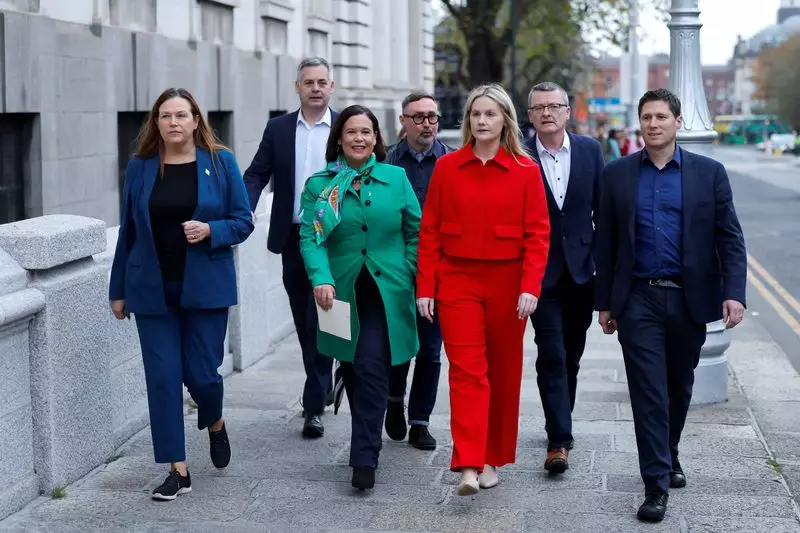Sinn Féin, a political party long associated with the quest for Irish nationalism and the unification of Ireland, appears to be at a critical juncture. Once seen as a formidable force poised to lead the government in Dublin, recent polling suggests a marked decline in their electoral fortunes just ahead of the upcoming election. This downturn not only jeopardizes Sinn Féin’s aspirations but also casts doubt on the broader objectives of Irish nationalists who find themselves in search of a unifying political movement. The juxtaposition of the party’s earlier confidence and its current struggles raises significant questions about the stability and future of Irish nationalism as a whole.
As 2023 has unfolded, Sinn Féin projected an image of imminent power—a government poised to cross borders and solidify its presence in both the Republic of Ireland and Northern Ireland. Fueled by a vision of facilitating a referendum on Irish reunification, Sinn Féin aimed to cement its legacy as a transformative force. However, as the election date approaches, it is increasingly clear that the party’s support base is fracturing, primarily driven by traditional working-class constituents expressing discontent over Sinn Féin’s more progressive stance on immigration matters. Such internal strife complicates the party’s attempts to rally support around the issue of Irish unity, which now appears to be taking a back seat in the minds of voters.
During election campaigns, it is common for parties to highlight pivotal issues that resonate with their constituents. However, in a recent two-hour canvass within one of Sinn Féin’s Dublin strongholds, there were few, if any, conversations surrounding the urgent topic of Irish unity. Instead, voters expressed significant concerns over pressing matters such as rising housing costs and insufficient public services. The sentiments of constituents like Deirdre Ní Chloscaí, a Dublin teacher, underscore a growing sentiment: The vision of a united Ireland has been overshadowed by immediate, tangible challenges facing everyday citizens.
The historical association of unity with Sinn Féin seems to be losing its grip as voters wrestle with more pressing socio-economic issues, demonstrating that the urgency for reunification is not at the forefront of citizens’ minds. It is noteworthy that even opposition parties, who traditionally would engage with the notion of unity, have relegated it to minor mentions in their electoral plans. Prime Minister Simon Harris’s Fine Gael, for example, has shown a stark preference for a gradual approach to unity, indicating a significant shift in priorities among political elites.
The fabric of Irish politics is changing, as rival parties, while acknowledging the historical weight of a united Ireland, have chosen to weave their messages around different, albeit somewhat muted, themes. The current government coalition has committed to fostering cross-border collaboration but has largely ignored the immediacy of a formal alignment towards a referendum on Irish unity. This political hesitance, coupled with Sinn Féin’s declining appeal, raises the alarming prospect of stagnation for the Irish nationalist movement.
Nevertheless, it is essential to recognize that the conversation around Irish unity has not completely dissipated. While Sinn Féin faces electoral setbacks, a significant portion of the electorate continues to harbor pro-unification sentiments. Most Irish citizens in the Republic express support for ending British governance in Northern Ireland, and there are underlying trends that suggest a shifting tide, particularly among younger generations that are increasingly questioning traditional political lines. Observations from recent census data reveal demographic shifts wherein Catholic communities, more inclined towards reunification, have begun to outnumber Protestant communities for the first time.
Experts like Colin Harvey, a professor at Queen’s University and advocate for national unity, highlight the necessity of a robust political coalition to make strides toward unity more than the contribution of any one party. The dynamics currently at play underscore the essential need for a wide-ranging engagement that involves diverse political and civic sectors, as national unity cannot solely hinge upon the electoral fortunes of Sinn Féin.
Looking towards the future, Irish nationalism may find itself at a crossroads demanding innovative strategies that transcend traditional party lines. The path forward will depend not only on Sinn Féin’s resolute standing but more crucially on the broader engagement of all sectors of civil society in the vision for a united Ireland. As the sentiment for reunification continues to incubate within the electorate, comprehensive dialogue and concerted effort will be paramount in transforming aspirations into actionable change—a challenge that may define Ireland’s political landscape for decades to come.

